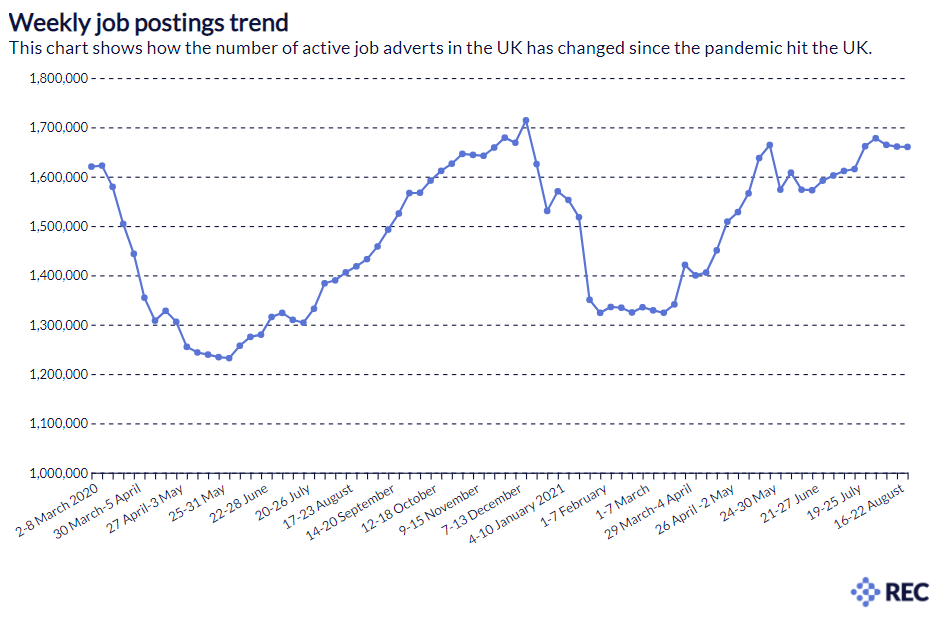- In the week of 23-29 August, there were 1.66 million active job adverts in the UK
- There were around 193,000 new job adverts posted in the same week
- New job postings numbers have remained high since early June, and labour shortages continue to be a concern for both government and businesses
- Dispensing opticians were in increasing demand last week, as well as driving instructors, and vehicle body builders and repairers
- Six out of the UK’s top ten hiring hotspots were in Scotland last week, as the country opened up further
- Meanwhile, six of the bottom ten local areas for growth in job adverts were in Northern Ireland
In the week of 23-29 August, there were a total of 1.66 million active job adverts in the UK, according to the Recruitment & Employment Confederation (REC)’s latest Jobs Recovery Tracker. The last five weeks have seen the highest weekly figures in job adverts since mid-December 2020.
The number of new job adverts being posted each week has remained high since early June. Last week there were 193,000 new job postings in the UK. This high level of demand continues as many sectors find themselves with a shortage of available workers and companies battle to recruit staff.
Neil Carberry, Chief Executive of the REC, said:
“Demand for workers remains very high across the economy and shows no signs of weakening. With businesses in the particularly squeezed food, logistics and hospitality sectors starting to gear up for Christmas, the months ahead could be difficult – even with a large number of people coming off furlough in August and September.
“It is worth remembering that some of this could be short-term. Large numbers of people are finding new work post-pandemic as the economy reshapes. But that realignment will take time, and there is good evidence to suggest that the market will remain tight for some years to come, even if the current crisis passes. Hiring businesses need to assess their workforce plans and work out how they are going to attract and retain the staff they need in the coming months and years. Recruitment businesses are best placed to help with this, as experts in the field. But employers also need government to work with them in a practical, co-operative way on skills, unemployment and immigration changes in order to get through this crisis.”
There was a significant increase in adverts for dispensing opticians last week (+26.4%), as well as for vechicle-related occupations such as driving instructors (+12.9%), vehicle body builders and repairers (+12.9%), and vehicle valeters and cleaners (+9.2%).
On the other hand, ambulance staff (excluding paramedics) (-10.1%), conference and exhibition managers and organisers (-9.7%), and standards and regulations inspectors (-7.9%) saw the biggest weekly declines in active job adverts.
On a regional level, Scotland has seen a steady increase in active job postings. Six out of the top ten hiring hotspots last week were in Scotland, the most notable being Na h-Eileanan Siar where numbers more than doubled (+134.8%). This was followed by the Shetland Islands (+11.0%), Orkney Islands (+7.5%) and East Dunbartoshire (+7.4%).
At the other end of the scale, six out of the bottom ten local areas for growth in active job postings were in Northern Ireland. Ards and North Down (-9.2%), Armagh City, Banbridge and Craigavon (-7.0%), and Derry City and Strabane (-7.0%) saw the biggest falls in Northern Ireland, but Sunderland saw the biggest drop in the UK (-21.6%).







